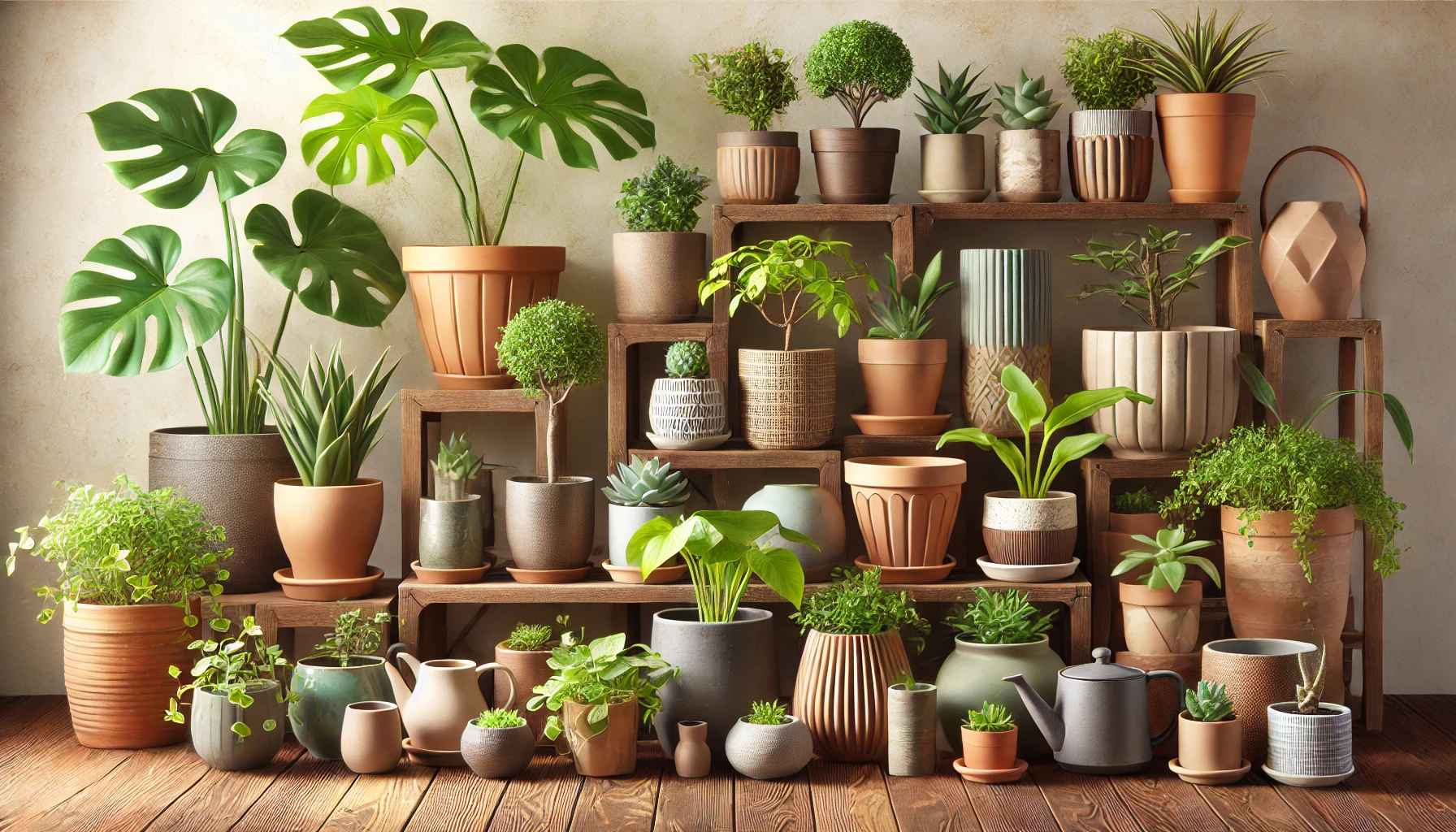Choosing the right pot is essential for the health and growth of your plants. The right container ensures proper drainage, supports root development, and complements your home’s aesthetics. In this guide, you’ll learn how to select the best pots for different types of plants.
1. Why Choosing the Right Pot Matters
A plant’s container directly affects its ability to thrive. A poor choice can lead to root rot, slow growth, or even plant death. Consider these key factors when selecting a pot:
- Drainage – Prevents overwatering and root rot.
- Size – Allows roots to spread and grow properly.
- Material – Affects moisture retention and temperature.
- Aesthetic – Enhances the beauty of your space.
2. Understanding Pot Materials
Each pot material has pros and cons. Here are the most common types:
Terracotta (Clay) Pots
- Pros: Excellent breathability, prevents overwatering, classic look.
- Cons: Dries out quickly, can be heavy and fragile.
- Best for: Succulents, cacti, and plants that prefer dry soil.
Plastic Pots
- Pros: Lightweight, affordable, retains moisture well.
- Cons: Less breathable, may cause overwatering if not well-drained.
- Best for: Tropical plants, ferns, and moisture-loving plants.
Ceramic (Glazed) Pots
- Pros: Retains moisture better than terracotta, stylish designs.
- Cons: Heavier and more expensive.
- Best for: Decorative indoor plants like orchids and peace lilies.
Metal Pots
- Pros: Modern aesthetic, durable.
- Cons: Can overheat in the sun, may rust over time.
- Best for: Indoor plants or those placed in shaded outdoor areas.
Wooden Planters
- Pros: Natural look, good insulation.
- Cons: Can rot over time if not treated properly.
- Best for: Herbs, small shrubs, and outdoor plants.
Fabric Grow Bags
- Pros: Lightweight, excellent drainage and aeration, promotes strong roots.
- Cons: Less stable, can dry out faster.
- Best for: Vegetables, root crops, and plants needing frequent repotting.
3. Choosing the Right Pot Size
The size of the pot affects plant growth. Here’s how to pick the right one:
- Too small: The plant becomes root-bound, leading to stunted growth.
- Too large: Holds excess water, increasing the risk of root rot.
General Size Guidelines
- Small plants: Choose a pot 1-2 inches larger than the current root ball.
- Medium plants: Go for a pot 2-4 inches wider than the root ball.
- Large plants: Select a pot 4-6 inches wider than the root system.
If repotting, increase the pot size gradually rather than choosing an excessively large container.
4. Drainage: The Most Important Factor
Good drainage is critical for plant health.
- Always choose pots with drainage holes at the bottom.
- If using a decorative pot without holes, place the plant in a smaller plastic pot with drainage, then set it inside the decorative one.
- Avoid overwatering—even the best pot won’t help if the soil remains too wet.
5. Choosing the Right Pot for Different Types of Plants
Succulents and Cacti
- Best pots: Terracotta or ceramic with drainage holes.
- Why: These materials allow excess moisture to escape, preventing root rot.
Herbs and Vegetables
- Best pots: Fabric grow bags, wooden planters, or deep plastic pots.
- Why: These plants need room for deep roots and consistent moisture.
Orchids
- Best pots: Special orchid pots with extra aeration holes.
- Why: Orchids need airflow to their roots and well-draining conditions.
Indoor Tropical Plants (Monstera, Philodendron, etc.)
- Best pots: Plastic or ceramic with drainage holes.
- Why: These retain moisture while allowing gradual drying.
Outdoor Plants and Trees
- Best pots: Large wooden or terracotta planters.
- Why: They provide stability and insulation for root systems.
6. Matching Pots with Home Decor
Beyond function, pots also contribute to the overall look of your home or garden. Consider these style tips:
- Modern decor: Minimalist ceramic or metal pots.
- Rustic charm: Wooden planters or aged terracotta.
- Bohemian vibe: Mixed pots with colorful or patterned designs.
- Industrial look: Concrete or matte black pots.
7. When and How to Repot a Plant
Plants eventually outgrow their containers. Signs that it’s time to repot:
- Roots growing out of drainage holes
- Water drains too quickly (soil is compacted)
- Plant stops growing despite proper care
How to Repot a Plant
- Choose a pot 1-2 inches larger than the current one.
- Fill the bottom with fresh potting mix.
- Gently remove the plant from its old pot, loosening the roots.
- Place it in the new pot and fill with soil around the sides.
- Water lightly to help the plant adjust.
8. Final Tips for Choosing the Best Pots
- Always prioritize drainage over aesthetics—healthy plants need proper water flow.
- Consider the plant’s natural habitat when selecting materials and size.
- When in doubt, choose a slightly bigger pot rather than a smaller one.
With the right pot, your plants will have the best environment to grow and thrive.

